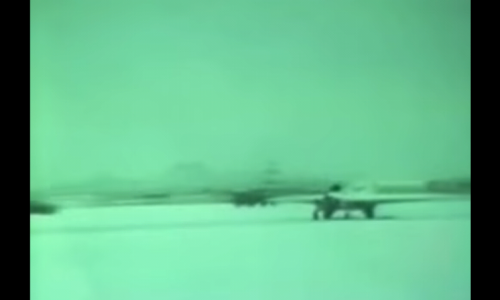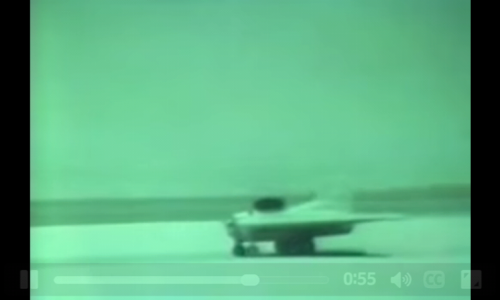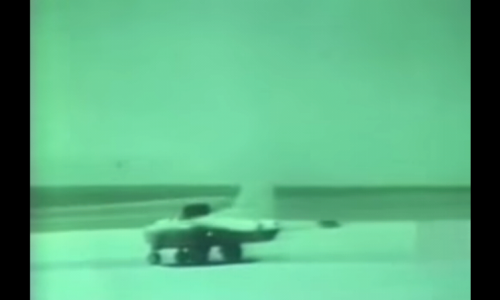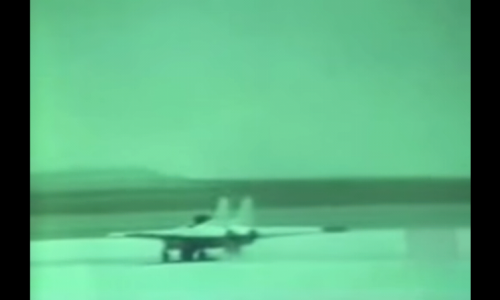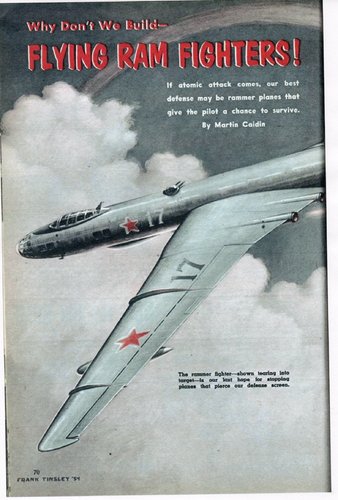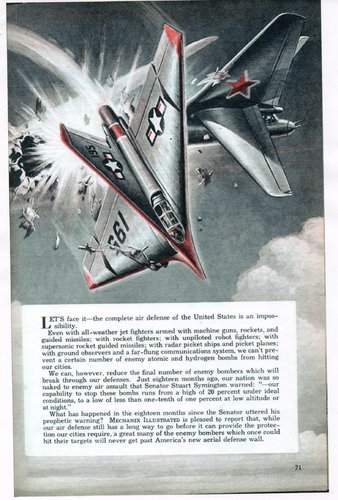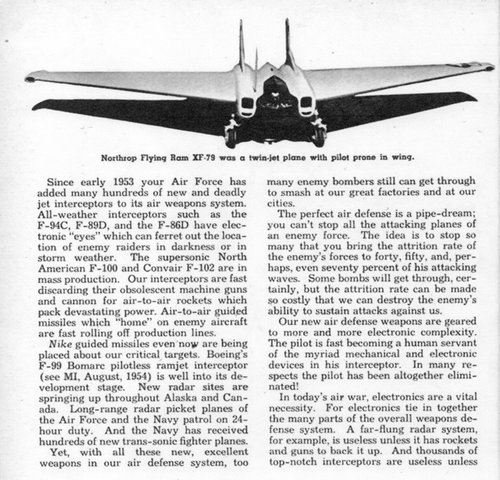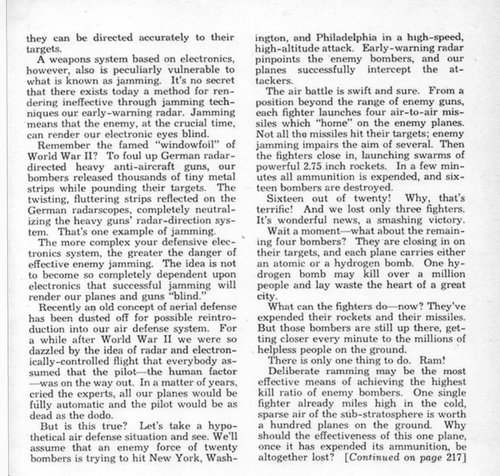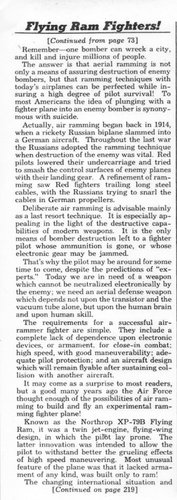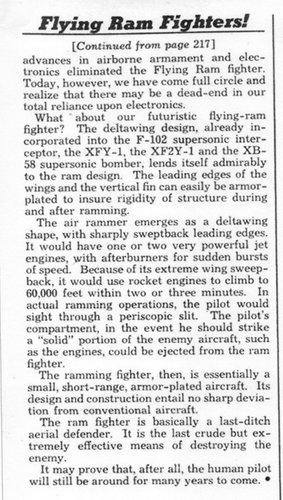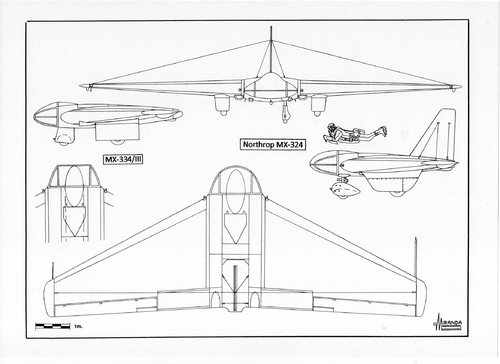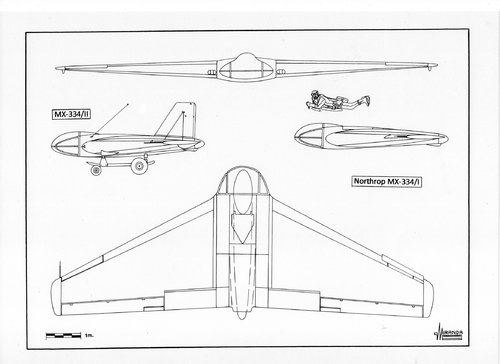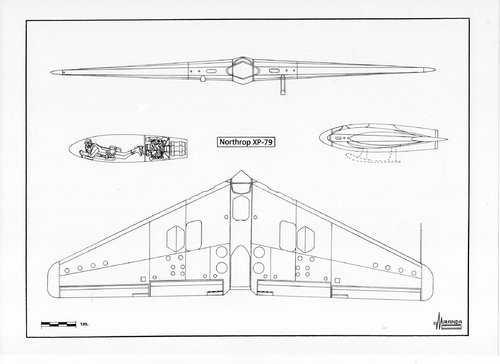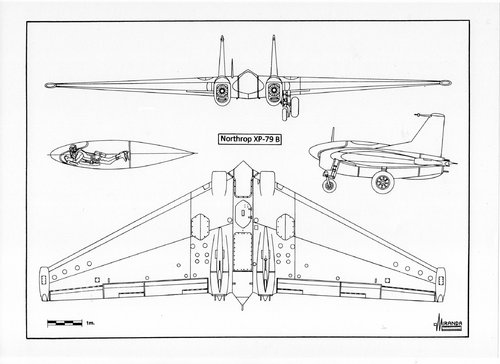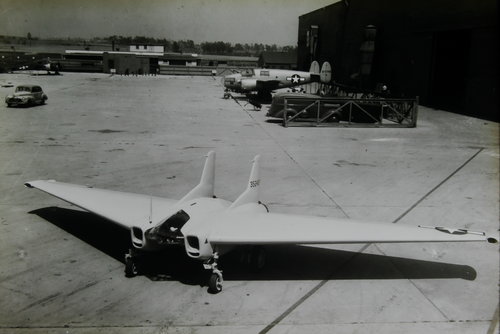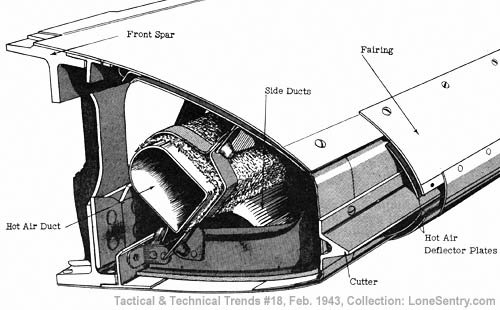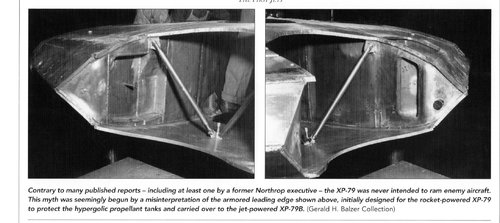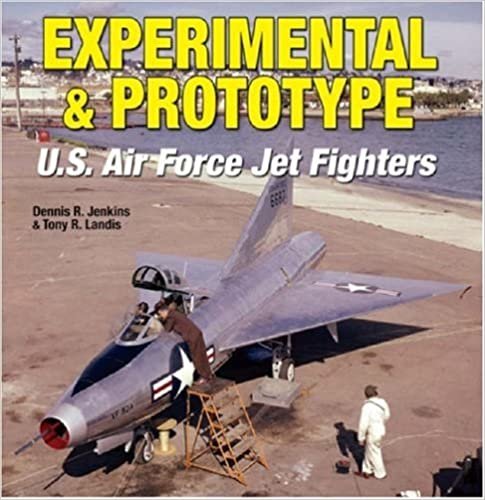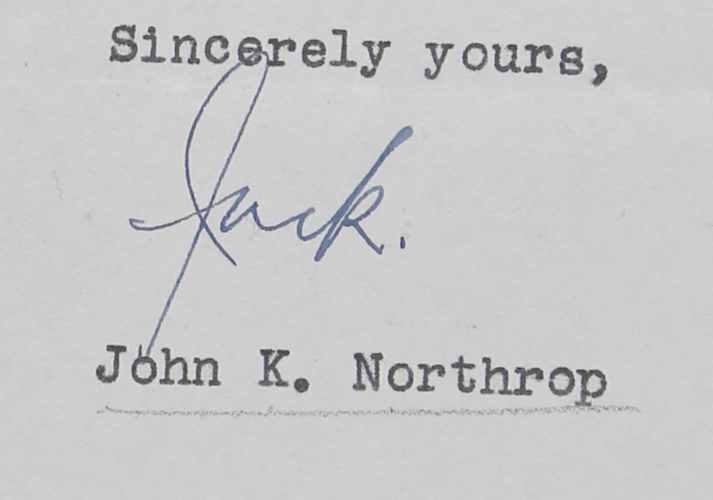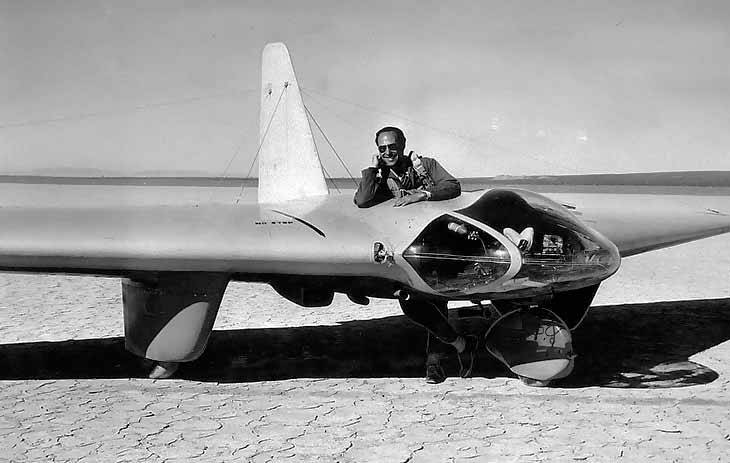You are using an out of date browser. It may not display this or other websites correctly.
You should upgrade or use an alternative browser.
You should upgrade or use an alternative browser.
Northrop XP-79
- Thread starter XP67_Moonbat
- Start date
windswords
ACCESS: Secret
- Joined
- 19 May 2009
- Messages
- 387
- Reaction score
- 193
Per the Youtube video posted by Blackkite, I found the flying wing drones fascinating, especially the Interstate XBDR. Maybe someone more knowledgeable than myself could start a thread on that.
XP67_Moonbat
ACCESS: Top Secret
- Joined
- 16 January 2008
- Messages
- 2,246
- Reaction score
- 377
Attachments
- Joined
- 5 May 2007
- Messages
- 347
- Reaction score
- 338
Footage of the Northrop XP-79 recently posted by the San Diego Air & Space Museum (SDASM) at their YouTube page. The footage shows some of the construction of one of the prototypes, along with some of the high-speed taxiing footage previously posted. The second half of the film is "Hermet Project" test footage of an unmanned Culver Cadet and then an unmanned B-17 used as attack drones to strike a target on a hillside.
YouTube: SDASM - MF 4 Northrop XP-79B Prototype and Hermit Project
YouTube: SDASM - MF 4 Northrop XP-79B Prototype and Hermit Project
Last edited:
XP67_Moonbat
ACCESS: Top Secret
- Joined
- 16 January 2008
- Messages
- 2,246
- Reaction score
- 377
It's a good thing I screenshotted images of the XP-79 from the video in my earlier post. Because THAT video is no longer available. :-/
- Joined
- 31 July 2013
- Messages
- 546
- Reaction score
- 1,074
Hi Overscan, took a little while to reply but I was there from June 2007 until the company was wound up at the end of March 2012VictorXL188 said:I have to admit that my previous employers, Aerospace Publishing, probably did something to perpetuate the ramming myth of the XP-79, when in a publication in the 1980s, ie pre-internet days, they published an artwork showing a production P-79 (or should that be F-79) ramming the tail of a Tu-16 Badger!
When were you there?
I did 2 weeks work experience there in 1991/92 (can't remember exact date), was a great experience.
Whenever I see the word myth on a forum, 9 out of 10 times, the word myth should not be there. What did our allies, the Russians, do during the war? Ram Luftwaffe aircraft. Go here and scroll down to the 5 April, 2019 post for some evidence:
 falkeeins.blogspot.com
falkeeins.blogspot.com
FalkeEins - the Luftwaffe blog
- Joined
- 16 February 2013
- Messages
- 132
- Reaction score
- 590
Loved the art work, especially the painting of the XP-79 in a roll over the desert..........Back in the '80's when I was researching the Bell XP-83 for the Wings/Airpower article I made contact with a civilian engineer from the fighter desk at Wright AFB who worked with Northrop on the XP-79. He was at Edwards when it crashed and his belief is that Harry Crosby lost control attempting a roll . He commented that Crosby continually commented during construction that he bet it would roll great. Upon take off he flew out of site and then crashed. This gentlemen also commented that he was on the selection board for who would take over the XS-1 flights after Slick Goodman demanded a high fee. He stated that Chuck Yaeger was chosen as of all the test pilots at Edwards capable, he was the only one who didn't have a college degree.
Nik
ACCESS: Top Secret
- Joined
- 15 July 2009
- Messages
- 1,139
- Reaction score
- 809
Perhaps 'Urban Legend' but, faced with 'too many' incoming Russian 'Bears' armed with city-buster nukes, RAF interceptor pilots of that era apparently accepted that, clean out of missiles and ammunition, they would have to trade their life for a city.
'Remember Coventry !!'
USAF / SAC pilots probably made similar calculations, 'Off The Record'...
Been a while, but I still vividly remember my parents giving adolescent me 'The Talk'.
No, not that one...
We emptied the sizeable nook 'under the stairs', prised up its floorboard nails to ease access to crawl-space.
Stocked nook with our camping gear, warm clothes, food, water, booze, meds, tools, books, seeds etc etc.
Including, very carefully padded, enough little brown, prismatic bottles of 'Collis-Brown Mixture' AKA 'Chlorodyne', a now-banned Victorian-style opioid cocktail, proven to enable open-fracture reductions, ease severe burns and/or 'mercy' a small herd of elephants.
There was also a 'very special' bottle of spiked Scotch that we could yield 'in extremis' to take out 'Bad People'.
We taped windows, braced the hall-way with diagonal ladders and a couple of builders' planks.
My young brother and I slept in a nest in the nook.
Parents, aunt, pretty mid-teen cousin would squeeze in should the sirens sound.
Worst case, if our Western UK port-city was ambushed by eg a thermo-nuke in double-bottom of 'neutral-flagged' freighter in dock, I was to access the crawl-space with tools provided, burrow out, endure, raise my young brother on Kipling, Euclid, Shakespeare, a couple of dictionaries, my pre-11+ school-books and my beloved 'Outlines of Science' and 'Elements of Physical Geography'...
Yes, that was 'The Cuban Crisis'...
Brrrr....
'Remember Coventry !!'
USAF / SAC pilots probably made similar calculations, 'Off The Record'...
Been a while, but I still vividly remember my parents giving adolescent me 'The Talk'.
No, not that one...
We emptied the sizeable nook 'under the stairs', prised up its floorboard nails to ease access to crawl-space.
Stocked nook with our camping gear, warm clothes, food, water, booze, meds, tools, books, seeds etc etc.
Including, very carefully padded, enough little brown, prismatic bottles of 'Collis-Brown Mixture' AKA 'Chlorodyne', a now-banned Victorian-style opioid cocktail, proven to enable open-fracture reductions, ease severe burns and/or 'mercy' a small herd of elephants.
There was also a 'very special' bottle of spiked Scotch that we could yield 'in extremis' to take out 'Bad People'.
We taped windows, braced the hall-way with diagonal ladders and a couple of builders' planks.
My young brother and I slept in a nest in the nook.
Parents, aunt, pretty mid-teen cousin would squeeze in should the sirens sound.
Worst case, if our Western UK port-city was ambushed by eg a thermo-nuke in double-bottom of 'neutral-flagged' freighter in dock, I was to access the crawl-space with tools provided, burrow out, endure, raise my young brother on Kipling, Euclid, Shakespeare, a couple of dictionaries, my pre-11+ school-books and my beloved 'Outlines of Science' and 'Elements of Physical Geography'...
Yes, that was 'The Cuban Crisis'...
Brrrr....
- Joined
- 2 January 2011
- Messages
- 334
- Reaction score
- 308
A bit more on the XP-79.
With regard to the armor beneath the leading edge of the wing, I believe that this installation has caused a great deal of confusion and assumptions about the use of the XP-79 as a RAM. I've outlined the reality of this use earlier in this stream and encourage all to read it. The armor in the leading edge had NOTHING to do with ramming. It was placed there to protect the very corrosive and explosive fuels from penetration from the front by machine gun bullets during attacks on enemy bombers. Period. It had absolutely no presumptive use for ramming as the USAAF had rejected the whole concept of intentional ramming before the war even began.
Yes, Jack Northrop had in mind that the XP-79 could be used as a RAM, and continued to reference that used in communications late into the war. I'm sure that those around Northrop picked up on this and believed it to be a true use of the aircraft. The AIR FORCE was having nothing to do with that in any way, shape or form. However, I believe it highly likely that the USAAF did nothing to discourage articles about ramming as a ruse against the Russians, perhaps in the hopes that the Russians would expend a lot of time and effort in developing aircraft that essentially had no effective use. It made excellent - and completely specious and misleading - press for the "experts" of the times. We've seen quite similar threads in the early suppositions and expounding about "stealth" aircraft in more recent times.
This whole notion about the XP-79 as a RAM appears to have a life of its own, completely unaffected by the facts.
Oh well.
AlanG
With regard to the armor beneath the leading edge of the wing, I believe that this installation has caused a great deal of confusion and assumptions about the use of the XP-79 as a RAM. I've outlined the reality of this use earlier in this stream and encourage all to read it. The armor in the leading edge had NOTHING to do with ramming. It was placed there to protect the very corrosive and explosive fuels from penetration from the front by machine gun bullets during attacks on enemy bombers. Period. It had absolutely no presumptive use for ramming as the USAAF had rejected the whole concept of intentional ramming before the war even began.
Yes, Jack Northrop had in mind that the XP-79 could be used as a RAM, and continued to reference that used in communications late into the war. I'm sure that those around Northrop picked up on this and believed it to be a true use of the aircraft. The AIR FORCE was having nothing to do with that in any way, shape or form. However, I believe it highly likely that the USAAF did nothing to discourage articles about ramming as a ruse against the Russians, perhaps in the hopes that the Russians would expend a lot of time and effort in developing aircraft that essentially had no effective use. It made excellent - and completely specious and misleading - press for the "experts" of the times. We've seen quite similar threads in the early suppositions and expounding about "stealth" aircraft in more recent times.
This whole notion about the XP-79 as a RAM appears to have a life of its own, completely unaffected by the facts.
Oh well.
AlanG
taildragger
You can count on me - I won a contest
- Joined
- 2 November 2008
- Messages
- 384
- Reaction score
- 440
If Jack Northrop thought the aircraft was capable of a ramming attack, there must have been something to it regardless of the USAAF's opinion of the tactic. An armored leading edge and wing structure capable of stopping or (more likely) deflecting incomming rounds would be entirely different than one designed for slicing through airframes. Northrop was a world-leading structural engineer and wouldn't be confused about this.
Last edited:
This whole notion about the XP-79 as a RAM appears to have a life of its own, completely unaffected by the facts.
But YouTube says it was a ram. Surely inaccurate information could not appear on YouTube...
I agreeA bit more on the XP-79.
With regard to the armor beneath the leading edge of the wing, I believe that this installation has caused a great deal of confusion and assumptions about the use of the XP-79 as a RAM. I've outlined the reality of this use earlier in this stream and encourage all to read it. The armor in the leading edge had NOTHING to do with ramming. It was placed there to protect the very corrosive and explosive fuels from penetration from the front by machine gun bullets during attacks on enemy bombers. Period. It had absolutely no presumptive use for ramming as the USAAF had rejected the whole concept of intentional ramming before the war even began.
Yes, Jack Northrop had in mind that the XP-79 could be used as a RAM, and continued to reference that used in communications late into the war. I'm sure that those around Northrop picked up on this and believed it to be a true use of the aircraft. The AIR FORCE was having nothing to do with that in any way, shape or form. However, I believe it highly likely that the USAAF did nothing to discourage articles about ramming as a ruse against the Russians, perhaps in the hopes that the Russians would expend a lot of time and effort in developing aircraft that essentially had no effective use. It made excellent - and completely specious and misleading - press for the "experts" of the times. We've seen quite similar threads in the early suppositions and expounding about "stealth" aircraft in more recent times.
This whole notion about the XP-79 as a RAM appears to have a life of its own, completely unaffected by the facts.
Oh well.
AlanG
Attachments
A few years ago I read that when the pilot is in a supine position he can easily withstand 10 G forces which this plane would make into quite a plane that could make sharp circles or dive from higher altitudes.
Yes yes for such a position I thoughtA few years ago I read that when the pilot is in a supine position he can easily withstand 10 G forces which this plane would make into quite a plane that could make sharp circles or dive from higher altitudes.
But how long could the pilot can fly in that position before his neck start to hurt
30-40 minutesYes yes for such a position I thoughtA few years ago I read that when the pilot is in a supine position he can easily withstand 10 G forces which this plane would make into quite a plane that could make sharp circles or dive from higher altitudes.
But how long could the pilot can fly in that position before his neck start to hurt
MarianHawke22
ACCESS: Restricted
- Joined
- 30 October 2019
- Messages
- 4
- Reaction score
- 9
I'm still wondering what the cause the XP-79 to lose control and spins-out which led to the crash. It is still a mystery to this day.
The secret to the stability of Horten designs was the bell-shaped distribution of lift, harmonizing washout, sweep back, taper, airfoil selection, aspect ratio and CG location. The absence of tailfin in the flying wings producing drag, due the mittleren effekt an aerodynamic interference between the air-flow associated to both wing panels.I'm still wondering what the cause the XP-79 to lose control and spins-out which led to the crash. It is still a mystery to this day.
The Hortens’ mitigated the induced drag using a bat tail configuration in the Ho IX V1 (W.-Nr.38, RLM 8-229).
All Northrop flying wings suffered controllability issues which were never fully corrected and numerous accidents: the N-9M-1 in May 19, 1943, the XP-56 in October 8, 1943, the MX-334 in November 10, 1943, the XP-79B in September 12, 1945 the YB-49 second prototype in June 5, 1948 and the YB-49 first prototype in March 14, 1950.
Northrops had not been designed using the bell-shaped lift distribution pattern theory, which guaranteed stability and suffered controllability issues caused by mittleren effekt (middle effect).
The Horten Brothers were questioned in May 9, 1945 by the U.S. Strategic Air Forces Intelligence in Europe staff (USSTAF A-2), in May 19-21 by Kenneth Wilkinson of the Royal Aircraft Stablishment (RAE), in September-October 1945 by the RAE Tailless Advisory Committee and during March 1948 by the U.S. 970th Counter Intelligence Command.
In March 1945, the Horten family house in Bonn was inspected by the British-American Combined Objectives Sub-Committee (CIOS) intelligence team who retrieved numerous documentation on the Horten sailplanes Ho I to Ho XII.
In June 7, 1945 the Ho IIIf and the Ho IIIh sailplanes were inspected at Wiesbaden by sailplane experts of the B.N. Slingsby British manufacturer.
In April 12, 1945 the U.S. Third Army retrieved parts of the Ho XVIII in Khala underground facilities and the Ho IX V3 prototype in GWF plant Friedrichroda.
The Ho IV, Ho VII and parts of the Ho VIII were recovered in Gottingen by the U.S. 8th Armored Division, along with a complete set of plans.
In August 1945 the Ho IX V3 prototype reached America and were displayed at Freeman Field AFB.
In October 1947 several sailplanes of the types Ho IIL, Ho IIIf, Ho IIIh and Ho IV were inspected by Northrop engineers at Hawthorne plant.
But despite all the Allied efforts to obtain information from the Hortens' they managed to preserve their secrets, including the most important of all: Stealth.
Like some rather more authoritative writers, I'm skeptical of the stealth claims made for the HoIX, which I saw years ago at the Smithsonian's Silver Hill storage facility. The steel-tube center section structure looked like it would reflect radar very well indeed. The wooden wing structure includes plenty of metal bits too. I had heard rumors of "stealth coatings" before I went. But all I saw was a medium grey undercoating or filler material here and there., no thicker than house paint.The secret to the stability of Horten designs was the bell-shaped distribution of lift, harmonizing washout, sweep back, taper, airfoil selection, aspect ratio and CG location. The absence of tailfin in the flying wings producing drag, due the mittleren effekt an aerodynamic interference between the air-flow associated to both wing panels.I'm still wondering what the cause the XP-79 to lose control and spins-out which led to the crash. It is still a mystery to this day.
The Hortens’ mitigated the induced drag using a bat tail configuration in the Ho IX V1 (W.-Nr.38, RLM 8-229).
All Northrop flying wings suffered controllability issues which were never fully corrected and numerous accidents: the N-9M-1 in May 19, 1943, the XP-56 in October 8, 1943, the MX-334 in November 10, 1943, the XP-79B in September 12, 1945 the YB-49 second prototype in June 5, 1948 and the YB-49 first prototype in March 14, 1950.
Northrops had not been designed using the bell-shaped lift distribution pattern theory, which guaranteed stability and suffered controllability issues caused by mittleren effekt (middle effect).
The Horten Brothers were questioned in May 9, 1945 by the U.S. Strategic Air Forces Intelligence in Europe staff (USSTAF A-2), in May 19-21 by Kenneth Wilkinson of the Royal Aircraft Stablishment (RAE), in September-October 1945 by the RAE Tailless Advisory Committee and during March 1948 by the U.S. 970th Counter Intelligence Command.
In March 1945, the Horten family house in Bonn was inspected by the British-American Combined Objectives Sub-Committee (CIOS) intelligence team who retrieved numerous documentation on the Horten sailplanes Ho I to Ho XII.
In June 7, 1945 the Ho IIIf and the Ho IIIh sailplanes were inspected at Wiesbaden by sailplane experts of the B.N. Slingsby British manufacturer.
In April 12, 1945 the U.S. Third Army retrieved parts of the Ho XVIII in Khala underground facilities and the Ho IX V3 prototype in GWF plant Friedrichroda.
The Ho IV, Ho VII and parts of the Ho VIII were recovered in Gottingen by the U.S. 8th Armored Division, along with a complete set of plans.
In August 1945 the Ho IX V3 prototype reached America and were displayed at Freeman Field AFB.
In October 1947 several sailplanes of the types Ho IIL, Ho IIIf, Ho IIIh and Ho IV were inspected by Northrop engineers at Hawthorne plant.
But despite all the Allied efforts to obtain information from the Hortens' they managed to preserve their secrets, including the most important of all: Stealth.
Flying wings are inherently stealthy in nature because of their low radar cross section and able to pass through the 20-50 MHz radar defences of the British ‘Chain Home’
But my point is that the Ho IX's radar cross section was unlikely to be low. The plywood skinning and wooden structural elements would be more or less invisible to radar. Wood neither attenuates nor deflects radio waves and thus contributes nothing to stealth. The radio waves pass through it, so the radar "sees" the steel tube truss, metal connectors, and engines as if there were no wing. I am not a radar expert. But multiple reflections from and between the angled truss components, metal flanges, metal fasteners in the wood structure, and the engines might make the radar cross section of the of the aircraft much larger than frontal area of the complete airframe would suggest. From what I remember, the angles in the welded structure might even make a good approximation of a set of corner reflectors.Flying wings are inherently stealthy in nature because of their low radar cross section and able to pass through the 20-50 MHz radar defences of the British ‘Chain Home’
- Joined
- 2 January 2011
- Messages
- 334
- Reaction score
- 308
Precisely, Iverson.
Well said.
The same is true for the B-35/B-49, which were huge chunks of flying metal skin with all sorts of metal interior structure. It would NOT have had any "stealth" characteristics whatsoever.
If I recall the tv show about the group that built a full-size model of the Ho 229 and then tested it on a radar stand, the model itself was - IIRC - built entirely of wood with no sort of metal interior parts at all. If I AM recalling correctly, their "tests" showing the "stealth" characteristics of the Horten were nearly completely meaningless. Corrections always welcome.
AlanG
Well said.
The same is true for the B-35/B-49, which were huge chunks of flying metal skin with all sorts of metal interior structure. It would NOT have had any "stealth" characteristics whatsoever.
If I recall the tv show about the group that built a full-size model of the Ho 229 and then tested it on a radar stand, the model itself was - IIRC - built entirely of wood with no sort of metal interior parts at all. If I AM recalling correctly, their "tests" showing the "stealth" characteristics of the Horten were nearly completely meaningless. Corrections always welcome.
AlanG
Last edited:
Actually, I'd expect the B-49 to be marginally stealthier than a B-36 or a B-52. If nothing else, the metal skin would reflect radar in in some directions away from the emitter and would hide the interior.Precisely, Iverson.
Well said.
The same is true for the B-35/B-49, which were huge chunks of flying metal skin with all sorts of metal interior structure. It would NOT have had any "stealth" characteristics whatsoever.
If I recall the tv show about the group that built a full-size model of the Ho 229 and then tested it on a radar stand, the model itself was - IIRC - built entirely of wood with no sort of metal interior parts at all. If I AM recalling correctly, their "tests" showing the "stealth" characteristics of the Horten were nearly completely meaningless. Corrections always welcome.
AlanG
Reflectance isn't necessarilly bad. Direction is what counts. I'm reminded of a radar gun test that I read that compared the radar cross section of an early Lotus Europa to a 70s vintage Corvette. The Europa was the favorite because of its vastly smaller frontal area, tiny rear-mounted engine, small radiator, and more seriously sloped body surfaces. The Corvette Had a giant radiator and that big iron V-8 up front. The Vette was the clear winner though. The Europa's little radiator stood bolt upright. The Vette's radiator was necessarilly much larger, so much so that it was angled back and apparently bounced most of the radar beam straight up, away from the V-8.
The Horten Ho 229 V3 restored in the Paul E. Garber facility was just a prototype built with moulded wood coating Formholz (15 mm plywood/carbon sawdust/plywood composition) and Tronal plastic.But my point is that the Ho IX's radar cross section was unlikely to be low. The plywood skinning and wooden structural elements would be more or less invisible to radar. Wood neither attenuates nor deflects radio waves and thus contributes nothing to stealth. The radio waves pass through it, so the radar "sees" the steel tube truss, metal connectors, and engines as if there were no wing. I am not a radar expert. But multiple reflections from and between the angled truss components, metal flanges, metal fasteners in the wood structure, and the engines might make the radar cross section of the of the aircraft much larger than frontal area of the complete airframe would suggest. From what I remember, the angles in the welded structure might even make a good approximation of a set of corner reflectors.Flying wings are inherently stealthy in nature because of their low radar cross section and able to pass through the 20-50 MHz radar defences of the British ‘Chain Home’
The V3 was used to test in flight the behavior of a flying wing powered by turbojets.
The production version would use anti-radar Schornsteinfeger paint.
It is believed that this type of structures might have certain Stealth capacity against the radars of the time, the ‘Chain Home’ reaction time would have had 8 minutes instead of the usual 19 minutes.
In August 1942 the Germans believed that the radar equipment able to operate on centimetric wavelengths could not be achieved until 1944. In December 1942 the Mosquito made the first accurate attack with the Oboe system (an application of their IFF identification system) although little afterwards the Germans could interfere it emitting on 1.25 m.
On 15 January 1943 the Technical Service of the Luftwaffe concluded that the centimetric wavelengths did not represent a military advantage that justified the effort to obtain them. That would have meant to retire all the available radio technicians from the war front, modify the production lines to manufacture new types of radio lamps, obtain bigger quantities of wolfram from the allied countries and delay the series production of the Neptun radar.
On 2 February a British Stirling bomber of the Pathfinder Force, that marked targets for an incursion against Hamburg, was shot down by the flak over Rotterdam. The examination of the wreck showed that part of its electronic equipment operated on 9 cm wavelength, it was one of the first H2S cartographic radars that could be recovered almost intact, as the self-destruction mechanism did not work.
It was based on the cavity magnetron technology, a casual discovery made by J.T. Randall and A. H. Boot in 1940. When the German technicians could make it work they were astonished by the quality of the images received through its small parabolic mirror. Geographical features or even the shape of ships and airplanes could be clearly distinguished at a time when the Lichtenstein SN-2 still operated on 3.30 m.
The German systems of manufacturing still took some time to adapt to the new technology and the overloaded electronic industry was only able to produce ten copies, denominated Berlin N-1, before the end of the war in Europe.
In May 1944 the Allied had been able to break the balance on their favour. The U-Boats were located and destroyed in the darkness, without any reaction from its Metox to the 9 cm. emissions. When the new Naxos were installed, the Allies started to emit on 3 cm and the slaughtering went on. In the air, the Lichtenstein were positioned by the Serrate devices of the Beaufighter and Mosquito night fighters and the German IFF was interfered by the Perfectos system.
The Oboe incursions resumed with the help of the 9 cm transmissions, impossible to interfere with the German equipment of the time. On 24 July 1943 the Bomber Command performed a mass attack on the heart of the Reich, using Window, interference equipment installed in the aircrafts, electronic decoys and long range escort night fighters Mosquito N.F. XII and N.F. XIII. The latest was equipped with nitrous-oxyde boost that also used successfully to catch the Focke-Wulf Fw 190 and Messerschmitt Me 410 night intruders during the Steinbock Operation.
The new Mosquito N.F. XIX night fighters received authorization to perform missions of free fighting over Germany, trying to attract the enemy night fighters with fake Monica radar emissions, feigning to be a bomber. By the beginning of 1945, the Mosquito N.F.30 came into operation with engines equipped with exhaust shrouds, designed for minimum IR emission and almost invisible in darkness. They were fast enough to hunt the Messerschmitt Me 262 B-1a/U1 jet night fighters and the Fi 103 flying bombs.
Germany lost the initiative and was forced to adopt a survivor strategy based on antiradar techniques and equipment.
To jam the radars of the Allied, aluminium bands similar to the Window British system (named by the German Düppelstreifen) were also used. Besides being launched from bombers in the classic way, launch rockets of 86 mm (similar to the current Chaff) were designed for the Kriegsmarine under the name Spgr.L/4.8 Kurhessen. They surrounded the ship in a cloud of metallic strips when detected by enemy radar. The U-Boats used the Aphrodite IV system (Fu MT1) since June 1943. They were radar decoy balloons coated with metallic painting that floated a few meters above the water surface anchored to a floating plate, producing a strong radar echo similar to that of the U-boat conning tower on British radar screens.
Another antiradar technique Netzhemd absortion durch was the manufacturing of radar-absorbent materials (RAM). The first practical application consisted of coating the U-Boat snorkels with a special compound of rubber and carbon named Sumpf that almost obliterated the radar profile. Its use was started in May 1944, with a plastic Zelligelit coating against water and pressure effects.
Coatings Tarnmatte and Wesch were developed shortly afterwards for other parts of the submarine, like the deck and conning tower. The first one was a thick sheet of Buna synthetic rubber that contained iron oxide powder used against the 9.7 cm wavelength of the H2S British radar. The second one was a carbonyl iron powder loaded rubber sheet, about 7.62 mm thick, with a resonant frequency at 3 GHz. The rest of the submarine hull was covered with Alberich anechoic coating, 4 mm thick rubber called Oppanol against the ASDIC sonar pulses.
There also existed an antiradar painting for airplanes, the Schornsteinfeger developed in the BHF Hochfrequenzinstitut of Travemünde. A radar camouflage material consisting of a thick bituminous paint heavily loaded with carbon. When applied in thickness carefully calculated in relation to the radar frequency the arriving signal would be trapped within the dielectric material and its return energy damped out and transformed itself in heat. The painting was more efficient if applied over non-metallic structures predecessors of the current composite materials.
The most efficient device was the Jaumann developed by IG Farben. It consisted of 8 cm thick panels formed by 7 layers of conductive material plastic/carbon separated by layers of di-electric Igelit polyvinylchloride. It was used against the wavelengths between 2 and 50 cm effectively reducing the reflectivity of -20dB over 2.15 GHz. However, it could only be manufactured in curved or straight panels, which made its use on aircrafts very difficult.
At least three aircraft manufacturers were experimenting with antiradar materials during the last months of the war. The designer Kurt Tank of the firm Focke-Wulf built the night fighter Ta 154 with wood to make it less easily detected by the radars of the Allied. The structure was of plywood Lignofol L90 and the coating was of a new plastic known as Dynal Z5 manufactured by Dynamit Nobel-Troisdorf.
The elasticity modules should be assembled with synthetic glue named Tego-Film (equivalent to the Araldite used in the British Mosquito). The Tego-Film was made of phenolic resin glues. Unfortunately it could not be used for the mass production of the Ta 154 as the Goldmann Company manufacturing plant that synthesised it was destroyed during the bombing of Wuppertal. The replacing of the Tego-Film by the Kaurit adhesive, manufactured by Dynamit AG in Leverkausen, was not possible due to its high acid rate that eventually destroyed the wood.
The Ta 154 was not the only casualty of the lack of Tego-Film, the construction of the prototype Lippisch P.11 Schnellbomber a flying wing powered with two HeS 011 turbojets, was also stopped. It was a fast bomber able to fly at high altitude by means of radio navigation devices and incorporated different antiradar technologies. The structure was of plywood and the coating of Dynal Z5.
It was expected that the high flight profile, the Stealth flying wing configuration and the Schornsteinfeger painting would make it impossible to detect. By the end of the war only the central section of the wing has been built.
On 18 September 1948 the YB-49 (42-102367) piloted by Northrop's chief test pilot Max Stanley, flew over the air defence station at Half Moon Bay, south of San Francisco, undetected by the powerful TPS-10 radar, with a range coverage of 120 nautical miles and a height-finding of 60,000 feet. When 636th Squadron technicians Detachment G visually located the strange aircraft flying over the Air Defence Direction Center, they informed the 636th staff in Kirkland AFB. The incident caused great concern among the US political and military leadership as huge sums had already invested in the creation of the LASHUP system, a chain of radar stations for the air defence of USA that they had already started to install. Northrop engineers were incredulous and decided to carry out detailed test on the stealth features of the YB-49. To that purpose they performed a series of flights during which a P-61C night fighter used its APS-720 AI radar to scan the bomber from different angles with conclusive results. The bomber repeatedly made invisible passes over civil and military radar stations that picked up other aircraft.Precisely, Iverson.
Well said.
The same is true for the B-35/B-49, which were huge chunks of flying metal skin with all sorts of metal interior structure. It would NOT have had any "stealth" characteristics whatsoever.
If I recall the tv show about the group that built a full-size model of the Ho 229 and then tested it on a radar stand, the model itself was - IIRC - built entirely of wood with no sort of metal interior parts at all. If I AM recalling correctly, their "tests" showing the "stealth" characteristics of the Horten were nearly completely meaningless. Corrections always welcome.
AlanG
It was known that the Soviets had captured the scientist Dr. Günther Bock in Eilenburg on 29 April 1945, together with two Horten prototypes, all the drawings of the Ho VIII buried by Horten employees of the Sonderkommado 9 near Kilenburg, a complete set of plans of the Ho IX and several engineers of the Gothaer Waggonfabrik Flugzeugbau firm, with extensive knowledge on RAM techniques.
At the beginning of the Cold War the Soviets adopted a policy of maximum secrecy to hide their technical inferiority.
In 1947 the U.S. intelligence organization lack of means to penetrate the Soviet curtain of secrecy collecting information concerning military bases or atomic research sites far from Moscow.
According to the Air material Command's Intelligence Department, the 95 per cent of the information available on the new types of Soviet airplanes had been obtained during the annual Soviet Air Day Show at Tushino Airdrome.
Within this concept, in which the mystery and the lack of information about what happened at the other side of the Iron Curtain favoured the curiosity of the western public, several journalists working in aircraft publications had the temptation to speculate what could be the next Soviet fighter.
In the 9 June, 1947 intelligence report, the U.S. attaché in Moscow Major Edison K. Walters informed the War Department that the Soviets had begun production of a jet powered version of the Horten Ho VIII, with 131 feet wingspan and thirty-three thousand pounds max weight.
The information was false, but the fear of losing technological superiority to the Soviets in the field of radar, and the possibility of Soviet-built stealth bombers, generated significant disagreements regarding defence strategy between the Department of Defence and the Northrop firm.
Last edited:
NARA II |
NORTHROP AIRCRAFT, INC.
CABLE ADDRESS “NORAIR”IN REPLY REFER TO
NORTHROP FIELD
HAWTHORNE CALIFORNIA
HAWTHORNE CALIFORNIA
JOHN K. NORTHROP
PRESIDENT
12 September 1945
General H. H. Arnold,
c/o Major General W. Hale,
Commanding Officer,
Headquarters, 4th Air Force,
San Francisco, California.
Dear General Arnold:
I promised to advise you concerning the first flight of the XP-79 as soon as it occurred. Unfortunately, I have to report a fatal accident in this connection.
The first take-off was made without incident at 7:00 a.m., this morning and the pilot flew the airplane to an altitude of eight to ten thousand feet above the flying field and for twelve minutes put it through its preliminary paces in a manner that Indicated his entire satisfaction with the stability, maneuverability and controllability of the ship. This portion of the flight Included steep and gradual climbs, medium dives and zooms. It also included rolling the ship rapidly from a near vertical right hand bank to a near vertical left hand bank, indicating good aileron control. The ship appeared to observers on the ground to be extremely fast, but unfortunately, the recording camera was destroyed and we have no record of how fast it was.
At the end of this period the plane was in a gradual climb at an estimated speed of 200 to 250 miles per hour when it went into a maneuver which appeared to observers on the ground to be a slow roll. The ship did not recover from this roll but continued to /turn about the longitudinal axis with the nose gradually dropping towards the ground. The appearance was as though the aileron had jammed in a deflected position. After several turns the pilot released his escape hatch and was seen to leave the airplane. According to reliable observers, his parachute released but trailed without opening behind him; the fall resulting in his death. The airplane crashed and burned near by.
Colonel M.S. Roth, who up until three months ago has been Chief Aircraft Project Officer at Wright Field and who is now en route to an overseas assignment, was witness to the accident. Colonel Roth was well acquainted with this project from its inception and was so favorably impressed with the way the airplane handled and its apparent speed in the preliminary part of the flight that he said he felt the project should be continued in spite of the disastrous first flight.
During the first minutes there was every indication of the full satisfaction of the pilot concerning the controllability and maneuverability of the airplane. In fact, I felt that the flight path indicated a certain degree of exuberance in addition. Pilot Crosby was the man who demonstrated the N-9-M (Flying Wing) for you at Muroc a couple of years ago. He was an exceedingly good pilot (of long experience, but on rare occasion has been known to be a bit unconservative in his flying. Whether he deliberately slow rolled the airplane and then for some reason could not recover from the maneuver, or whether some type of control failure got him into the trouble, may never be known. At least at the present time we have no indication of which of these alternatives started the difficulty, although we favor the latter hypothesis. Pilot Crosby had slow rolled other of our tailless airplanes without difficulty and could not be severely censored in this case even if the maneuver was deliberate, as such maneuvers are expected of fighter aircraft, though perhaps not on the first test flight. Mr. Crosby apparently left the airplane successfully through the escape hatch and had ample altitude on leaving the plane to have landed without serious harm, if his parachute had functioned properly. A preliminary examination has indicated no damage to the chute or reason for its fouling.
I regret that this report is so unfavorable and can only conclude that we have been subject to one of the unfortunate accidents that seem to be associated with this business. In spite of our highly unconventional aircraft the record of pilot loss by this company is far better than that of any other company that I know of which has been building only conventional types, so perhaps we should not be too down hearted. I
I do not feel that this particular accident can be attributed to the type of airplane under test. There is, of course, a tendency to place the blame in this fashion, which I hope will not affect your ideas on the subject.
This report has been written on the day of the accident and is, of course, subject to review if additional evidence is uncovered.
Sincerely yours,
/s/
JACK
John K. Northrop
JACK
John K. Northrop
P.S. From information just received, it appears that the pilot was hit by a portion of the airplane, probably a wing tip travelling at relative high velocity, at the time he left the ship. The parachute failure can then be logically explained by its partial release from its cover by the impact rather than by any effort of the pilot. This would account for the cloth trailing rather than opening in a normal fashion.
Attachments
NARA II |
AFDMA-1A/Gen Crawford /RRG/hbr /71150
Written 26 September 1945
8 OCT 1945
Written 26 September 1945
8 OCT 1945
Mr. John K. Northrop, President
Northrop Aircraft, Inc.
Hawthorne, California
Dear Jack:
I have your letter of 12 September 1945 and am indeed sorry to hear of the unfortunate accident to the XP-79 during its first flight.
I can well understand your reaction to an incident of this type after more than 2 years of intensive development and all the disappointments that go with an unconventional project.
From your description of the accident and other information which I have been able to obtain, I am inclined to agree with you that the difficulty was due to a jammed aileron or something of the like since it appears that the airplane did have reasonably satisfactory flying and handling qualities.
I am sure that you will not be inclined to discontinue your researches along the lines of flying wing aircraft because of the loss of the XP-79 and in this you have my very best wishes for success.
Sincerely yours,
SIGNED
H.H. ARNOLD,
Commanding General, Army Air Forces
H.H. ARNOLD,
Commanding General, Army Air Forces
DISPATCHED
3 OCT 1945
AFAAG
CS-178622
- Joined
- 13 June 2007
- Messages
- 2,029
- Reaction score
- 2,251
How about bring this one up from the dead....I just LOVE the Flying Ram!
What about some trivia quiz on top of it? Here goes: who can identify thebirdiebirdies in the background? ;D

The biplane looks to be a WACO UPF based on the landing gear/strut configuration. The other appears to have a serial of 42-117xx which makes it an Fairchild AT-21-FB.
Enjoy the Day! Mark
Apollo11Reporter
ACCESS: Restricted
- Joined
- 20 September 2019
- Messages
- 1
- Reaction score
- 1
“Ram” may have also referred to the “ram air” that was used to operate the bellows that actuated the control surfaces, a system Northrop also used on the N9M.The XP-79 wasn't, and certainly not the P-78 either!!!saturncanuck said:The XP-78 was NEVER intended to shoot down enemy planes by ramming them!
On a serious note, the very notion that an aircraft with such a prominent glazed cockpit could be used for "ramming" enemy aircraft is so ludicrous I'm even surprise anyone could have come up with it!!! I could be wrong but I would be inclined to believe that the names "Ram Wing" and "Flying Ram" used to describe the MX-334/-324 and XP-79B aircraft refered more to their shape than an actual projected mission...
T. A. Gardner
ACCESS: Top Secret
- Joined
- 18 February 2021
- Messages
- 882
- Reaction score
- 1,516
Wikipedia confirms it! How can you not believe 2 TWO sources on the Internet?This whole notion about the XP-79 as a RAM appears to have a life of its own, completely unaffected by the facts.
But YouTube says it was a ram. Surely inaccurate information could not appear on YouTube...
View: https://www.youtube.com/watch?v=uFBqNBvY-9A
Why do people (ignorant easily mislead people) believe that the US should be held to a "higher standard" then other nations such as Germany or Italy when the US was toe to toe and even heads and toes above those two in terms of crimes against humanity and outright barbarity.
Well, there it is. The dumbest thing I've read all day.
- Joined
- 3 September 2006
- Messages
- 1,387
- Reaction score
- 1,214
If you noticed, this newcomer-with-an-attitude did spit lots of contempt today.Well, there it is. The dumbest thing I've read all day.
Rarely seen some bonehead begging to be banned so fast.
Rarely seen some bonehead begging to be banned so fast.
Edgelords gotta edgelord.
XP67_Moonbat
ACCESS: Top Secret
- Joined
- 16 January 2008
- Messages
- 2,246
- Reaction score
- 377
What an imbecile.
T. A. Gardner
ACCESS: Top Secret
- Joined
- 18 February 2021
- Messages
- 882
- Reaction score
- 1,516
Similar threads
-
Missiles To Space Launchers
- Started by XP67_Moonbat
- Replies: 2
-
-
-

